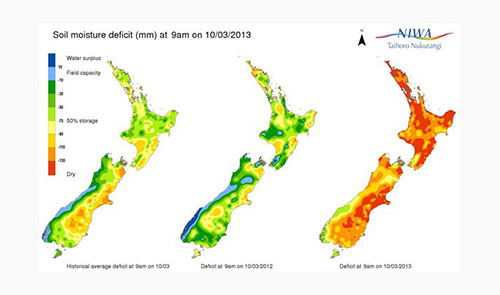Summer’s devastating side effect
Cast you mind back to summer 2011-12 and if you lived in Auckland you will probably be saying “what summer”? It felt like we emerged from winter into perpetual spring. The rain was constant and the sun fleeting.
This summer is the polar opposite. It may have started off with a few hit and misses. As usual Christmas day threatened rain however from early January it has been as if the country moved itself into another climate zone. The last time I remember a summer like this was when I was about eight years old.
However back to today and things are not looking good for our native plants and animals. I knew things were getting serious when our garden of natives started dying. I don’t have much of a green thumb so let’s just say they’ve received little attention from me over the years. They’re robust little blighters, so if they were dying, I knew it was serious.
This is reflected across the North Island.
On the Hauraki Gulf Island of Motutapu, over half a million native species have been planted on the island, yet the drought has meant that nearly 6000 plants have died over the summer.
Not only are new plantings dying off but century old plants are also suffering. Stuff has reported that trees in Auckland such as rimu are beginning to show signs that they are no longer coping with the dry weather.
The media has also been highlighting the plight of our native animals.
Recently kiwi have been found in open fields on farms curled up dehydrated and on the brink of death. They go out in the night time hunting for food and when they can’t find any in the forest they head out into the open. The grubs are harder to find, and the ground is so hard, that many younger kiwi were unable to penetrate it with their beaks.
Nicola Toki explains that when the sun comes out they curl up and just lay there, and with no food from the night before they begin to starve, dehydrate and can’t get up.
Our native duck species pateke are also beginning to suffer from the drought as mud and water sources dry out. In a Radio New Zealand story, Tawharanui Regional Park is suffering great losses of this endangered duck.
Jo Greenman, a DOC ranger from Matiu/Somes Island spoke to Radio New Zealand about how the local tuatara population on the island normally thrives throughout summer however this summer they have retreated into their burrows because the heat level is too intense for them.
So, what can you do to help?
The obvious advice is to leave out water for birds if there is no readily available source of water for them. Please take care to ensure though that it is high enough up to avoid predators, and not too close to humans. If your gardens are visited by tui then you may want to mix in some sugar with the water.
If you find a bird in need of attention then the best thing you can do for it is to take it to a local bird rescue centre. The SPCA Auckland has a great page on how and what to do when it comes to saving a bird, while the New Zealand Bird Rescue Charitable Trust has a directory of bird rescue centres in the main cities.
If you have had plants that are dying or even if you are planning on replanting after the drought a great way to help encourage native wildlife is to plant natives.
Landcare Research has a great tool that has been built to help select the best plants to grow. This will help reduce dieback should this unfortunate weather return in the future.

